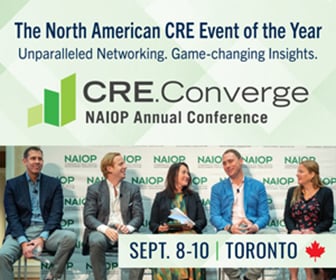Diversity and Inclusion: 'You Have to Have This Conversation'

Industry leaders share advice on how to turn lofty ideals into concrete plans for action.
It’s no secret that the commercial real estate industry has some work to do before it truly reflects the full range of diversity within North America.
For example, Deloitte's 2019 Commercial Real Estate Industry Outlook reveals that 93 percent of pension funds and 95 percent of hedge fund investors don't think the industry is prepared to recruit, engage and retain Millennial and Gen-Z workers.
Additionally, the report finds that “CRE companies should become more intentional about improving senior leader and board diversity, with specific targets to recruit women and minorities.”
During NAIOP’s Chapter Leadership & Legislative Retreat, held in February in Washington, D.C., a panel discussion highlighted notable efforts by three NAIOP chapters to promote greater inclusivity in the workplace.
CRE Summer Camps
Expanding the pipeline of talent into the commercial real estate industry has long been a concern, said Debbie Koenig, executive director of NAIOP Georgia, and it’s important to reach potential employees when they’re young. But that hasn’t always been easy.
“Not many people in high school say, ‘I want to be a broker,’ unless CRE is part of their family,” she said.
To address the pipeline problem, NAIOP Georgia launched a groundbreaking program in 2017: a two-week summer camp for high school students that’s focused exclusively on the commercial real estate industry. CRE Experience, which was held at Georgia State University in Atlanta, was developed by NAIOP Georgia and the university in partnership with Nexus Programs and the Real Estate Executive Council.
“These are young people thinking they want to be lawyers, doctors or other things,” said Koenig. “But we bring them to Georgia State to immerse and expose them to the numerous opportunities in our industry. However, you have to make it applicable to the students, and it also has to be intriguing to the parents. You won’t find many parents who will let kids go to CRE camp unless there’s a scholarship or SAT prep available.”
Twenty-seven teens from six states participated in the program, “which included an SAT prep course, advanced software skills development, self-discovery exercises and presentations by a variety of guest speakers,” according to an article on the camp from the Summer 2018 issue of Development magazine.
Koenig said when camp graduation rolled around, many students were visibly excited about opportunities in the industry.
“The students were so enthusiastic about what they had learned and say things like: ‘I can be an international lawyer in commercial real estate!’ Also, there were students who absolutely changed their major because of this camp,” she said.
Koenig added that it might take a while before NAIOP Georgia knows how many students go into commercial real estate because of the camp. However, she thinks seeds have been planted in the minds of many young people who took part in the program.
Georgia State was so impressed with the camp that it moved it to the honors campus for the second year in 2018. NAIOP Georgia was more prepared the second time, too; the chapter had a task force working on the camp six to eight months ahead of time.
That readiness requires a lot of work, though — along with a lot of outreach.
“This may be the most volunteer-intensive endeavor your chapter can carry out,” she said. “It takes a lot of time and a lot of planning ahead. Be prepared for changes when working with different entities and be prepared to be flexible. Don’t wait to get started. Get a tight group of people willing to get started. Reach out to local commercial real estate legends in your area.”
Young Weekend Warriors
SECO Development, Inc. Senior Vice President of Planning and Development Rocale Timmons, membership chair of NAIOP Washington State, described her chapter’s success with a condensed CRE camp. In November 2017, the chapter brought together 20 teens for its first weekend immersive experience, which was held in collaboration with the University of Washington.
Development also reported on the camp in the Summer 2018 issue.
“The program’s hands-on experience provided a brief introduction to careers in the built environment, with a focus on negotiations between brokers and sellers, architecture and mixed-use development,” according to the article.
“We know teens have short attention spans,” Timmons said, making the shorter program perfect for young minds. “Getting them exposed to different places in the industry that they can intersect was extremely valuable.”
So what made the program successful? Timmons said corporate sponsors like Amazon, as well as contributions from chapter volunteers, certainly helped. But offering a program that generated interest among young people was far and away the most important element.
“You have to have something teenagers want to work on,” she said.
However, Timmons said it’s an expensive effort for an individual chapter.
“We set aside $50,000 for this weekend,” she said. “It was certainly a worthwhile investment, but it’s not as sustainable as we would wish. So we’re seeking partners.”
The weekend CRE camp also motivated NAIOP Washington State to add a standing diversity and inclusion committee.
“We decided it was necessary,” Timmons said. “We've dedicated at least one event per year to diversity and inclusion. We’re also looking to draft a white paper for best practices when it comes to hiring or diversity programs.”
Finally, she said it’s important to define “diversity” in a way that’s relevant for the market served by a NAIOP chapter.
“We have started to go down this path where we also created a task force of members to figure out what diversity and inclusion means for our chapter,” she said. “We’re diverse in terms of product types and gender, but not so much on the cultural and race front. We needed to identify our blind spots. There is a business case for diversity of thought. Make sure everyone in your community is represented.”
A Woman on Every Panel
Cindy McSherry, executive director of NAIOP Chicago, said a comment during a board meeting about including a woman on every panel discussion or presentation that the chapter puts on led to an initiative that has generated tangible, positive results.
“People noticed that little, teeny tiny step," McSherry said.
McSherry said she realized that the lack of women in the industry unintentionally caused her to set up panels that were almost exclusively male.
“You go to what’s easy when you’re putting together a program, and often you know mostly men,” she said. “You have to be a little more thoughtful.”
NAIOP Chicago also launched a scholarship program to boost diversity with an equally simple decision — shifting proceeds from a chapter gala into real estate-related scholarships at DePaul University, Marquette University and Roosevelt University. (The latter has a strong program for people of color.)
To mark the fourth year of the program, NAIOP Chicago put together a video to challenge the city’s commercial real estate industry to be more inclusive.
McSherry said messages promoting diversity can be powerful, but she stressed that the topic must come up more than once or twice a year. She urged NAIOP chapters to create a position on their boards focused on diversity and inclusion.
“You have to have this conversation at every single monthly board meeting,” she said. “It may not solve every issue, but it has to be on the agenda.”
Trey Barrineau is the managing editor of Development magazine.
A version of this article originally appeared on NAIOP’s Market Share blog. For more posts on a variety of CRE-related topics, visit blog.naiop.org.




